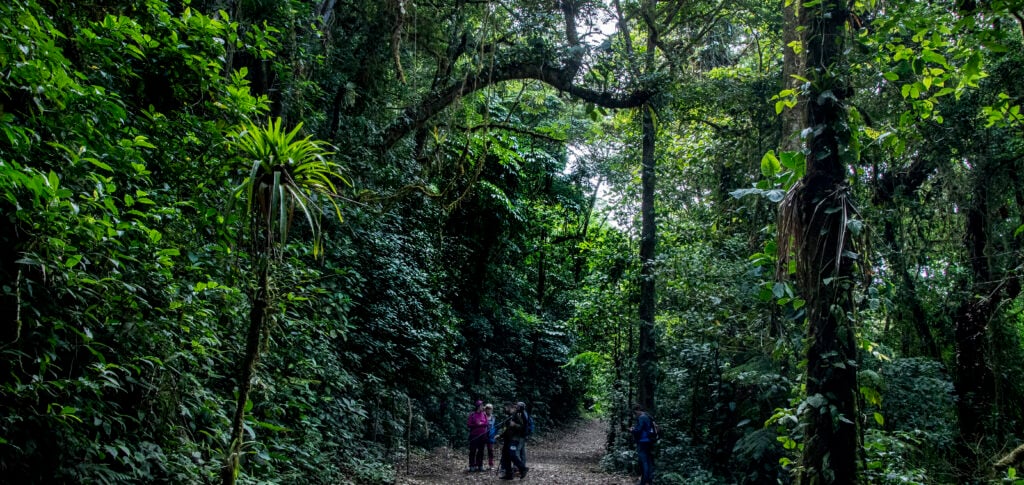Where one should hear the incessant dripping of condensed water between the treetops, one can now hear the creaking of branches under the feet of tourists, who walk along dry trails that should be soaked.
ADVERTISING
The forest resists with an infinite palette of shades of green, in the face of the global increase in temperatures and the decrease in humidity, but the cloudiness that has always surrounded it is increasingly scarce or practically non-existent, says guide Andrey Castrillo, resignedly.
“The forest should be cool,” he says. “We should be hearing the drops falling all over the jungle and that doesn’t happen anymore. It occurs during the rainiest and windiest seasons, when it still lasts a little”, highlights the 24-year-old guide.
“Here you don’t see the sun, or you didn’t see it. We had about 30 sunny days a year. Today, we have more than 130”, adds Castrillo.
ADVERTISING
The Monteverde private nature reserve sits 1.400 meters above sea level and spans 14.200 hectares of protected area. It is home to 100 species of mammals, 400 birds and 1.200 amphibians.
This particular forest ecosystem covers 1% of the world's territory of tropical or subtropical zones in mountainous locations and with unique atmospheric conditions to allow cloud cover.
“Clouds at surface level usually form from a humidity saturation greater than 90%, accompanied by temperatures that generally range between 14 and 18 degrees (Celsius)”, explains researcher Ana María Durán, from Environmental Contamination Research Center at the University of Costa Rica.
ADVERTISING
The meteorological station at the University of Costa Rica in Monteverde indicates that, since 2017, the average temperature has fluctuated between a maximum of 26,82ºC and a minimum of 4,5ºC.
“It makes me sad”
For more than 20 years, Durán visited Monteverde, in the province of Puntarenas, approximately 140km from the capital San José.
The “almost permanent” cloudiness that characterizes this ecosystem generates the sensation of “practically walking among the clouds”, said Durán, 38 years old.
ADVERTISING
Visibility should only be one meter from the trail, but now it is possible to see the depth of the forest on a morning with temperatures above 25ºC and a clear, cloudless sky.
Tourists are grateful for the weather as they explore the forest wearing tank tops, shorts and sandals, rather than wearing boots and raincoats, as would generally be necessary in the cloud forest.
According to experts, climate change also affects Monteverde and the cloudiness that was previously generated and maintained among the treetops slightly exceeds the height of the mountain tops.
ADVERTISING
“The base of the cloud is no longer on the surface, as we are increasingly starting to see it higher up”, explains Durán.
“Arriving in Monteverde and being faced with such dry conditions and not the clouds, which I saw, for example, 20 years ago, when I started visiting the ecosystem, obviously brings enormous sadness”, highlights the researcher, regretfully.
Species extinction
The higher temperature, lower humidity and greater radiation clear Monteverde's clouds and increase the threat to flora and fauna species.
Moss dries on the bark of huge trees, rivers have turned into streams, and amphibians are the first species to be affected by climate change.
Biologist Andrea Víncent, professor at the University of Costa Rica, explains to AFP that the water imbalance is “very large”, as there is less water than the ecosystem needs.
“The decline [in the number] of amphibians in the cloud forest could be a warning sign”, he indicates.
The “Incilius periglenes”, known as the golden or Monteverde frog, for example, has already been affected and has been considered an extinct species since 2019, according to the Red List of Threatened Species of the International Union for Conservation of Nature.
“There will be many extinctions” with climate change, warns the 42-year-old biologist. “A cloud forest that no longer has a cloud formation will disappear, there is no alternative,” she laments.
For this reason, she appeals to attack this “discouraging scenario” produced by climate change.
“Ecosystems are resilient and if we make an effort to stop climate change, cloud forests may not return in our lifetime. But, perhaps, yes in the next generations”, says Vincent.
Read also
* The text of this article was partially generated by artificial intelligence tools, state-of-the-art language models that assist in the preparation, review, translation and summarization of texts. Text entries were created by the Curto News and responses from AI tools were used to improve the final content.
It is important to highlight that AI tools are just tools, and the final responsibility for the published content lies with the Curto News. By using these tools responsibly and ethically, our objective is to expand communication possibilities and democratize access to quality information. 🤖




